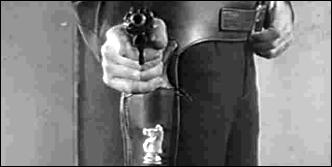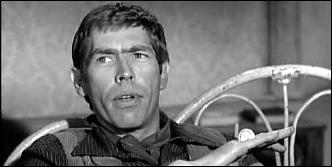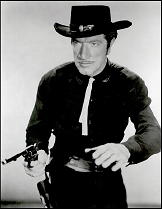Reviewed by DAVID VINEYARD:
“The Gladiators.†An episode of Have Gun – Will Travel, 19 March 1960. (Season 3, Episode 27.) Richard Boone. Guest Stars: Paul Cavanaugh, Dolores Donlon and James Coburn as Bill Sledge. Teleplay: Robert C. Dennis. Series created by Herb Maddow and Sam Rolfe. Directed by Alvin Ganzer.

Have Gun – Will Travel was seldom just an ordinary western, and on occasion barely a western at all, as in this episode which opens in San Francisco at our hero Paladin’s (Richard Boone) rooms in the Carleton Hotel where he is receiving an attractive young lady, Miss Alison Windrom (Dolores Donlon) of New Orleans, with seduction on his mind, as evidenced by the champagne that accompanies her to the room and his lounging jacket.
Alas for our tarnished knight, Miss Windrom is concerned for poor Daddy back home (veteran actor Paul Cavanaugh), who has accepted a challenge to a duel:
“He’s a very proud man, Mr. Paladin, he’d rather die than yield.â€
“Is that a family trait?â€
It is the nineteen-fifties, and we know the seduction is not going to succeed, but the teleplay and Boone’s delivery of the lines makes no bones about what Paladin has in mind. It isn’t surprising audiences were ready for the much more successful James Bond a few years later. All this unfulfilled seduction and innuendo had to end at some point in a bedroom somewhere.

Of course once he is hired, Paladin is all business. In that he, and most of the gunslingers in Westerns, very much resemble the work ethic of the private eye of pulp fiction, all business, no matter how attractive the distractions. In many ways Paladin is a private eye as much as a hired gun, though he is seldom cast in the role of detective.
Over the course of the series we learn little of him other than he is an ex-soldier, fast with a gun, would rather talk than fight when possible, has exquisite tastes acquired if not born to, is possessed of a mordant and quick wit, and is cynical but still a romantic despite his jaundiced eye.
He would like to be wrong about people and is gratified when he finds one of the few who defy is dark assessment of humanity. He is a man out of his time and place who probably would only really fit in San Francisco of that era or as an Elizabethan privateer. He is very much Chandler’s errant knight ‘good enough for any world,’ but his mean streets are most often dusty trails ending in a showdown.

Miss Windrom is convinced the other party in the duel, the younger Mr. Beckley (George Neise) will step out if Paladin shows up as a proxy for her father. So Paladin gets dragged into it, protesting all the way, and steps into the looking glass with the Southern aristocrats who would rather die than yield, even if it means over the bodies of innocents.
Or not so innocents, when Beckley hires his own proxy in the person of gunfighter Bill Sledge (James Coburn) from Texas, a man with a reputation with a gun equal to Paladin. The two men know of each other, and they meet on neutral ground with mutual respect for the other’s skill and professionalism. That paean to professionalism is also a throwback to the classic private eye of Hammett who is redeemed more by that trait than his humanity, the Code of the West is ironically largely the Puritan work ethic.
Paladin considers the duel nonsense, and so does the dark but charming Sledge. Neither particularly wants to kill anyone, certainly not for two arrogant fools battling over some obscure point of honor, and it seems for a moment like the meeting on the field of honor and blood can be avoided if Paladin and Sledge refuse to fight, but Sledge can’t help but wonder which of them would win, and …
Sledge: I never done much of this kind of fighting in Texas. Hear tell there’s rules.

Paladin: You pay much attention to rules?
Sledge: Never done yet.
This episode is a tight little psychological game, as Paladin finds himself Alice surrounded by White Rabbits and Mad Hatters obsessed by ‘honor’ and inured to death. He finds the price of honor in this case too high, but no one else does, and as the tight little half hour goes on he inevitably will find himself on that field of honor and blood at dawn.
· Paladin: “How much blood will you settle for?â€
The episode may surprise some who have a certain view of series drama from the Fifties. It is bitter, cynical, downbeat, dark, and unforgiving. That the conclusion is predetermined and unavoidable from the first makes it all the worse. It has the sharp taste of bitters without the gin, a nasty dose of quinine made palatable by watching two outstanding actors, both gifted at playing villain and complex hero, both with charm and cool to spare (had this episode also included those two other masters of small screen cool, Steve McQueen and Robert Culp, it could have frozen and shattered television tubes) in acutely observed and written roles clearly enjoying themselves.

Coburn displays the vicious charm that worked equally well as dark hero or psychotic villain and would soon lead him to stardom, and Boone, who has the same qualities on screen, seems to enjoy his scenes with him, recognizing an equal. That, and the sharp observation of a world where honor encompasses wagering on death and wasting lives over obscure points make this episode a standout as Paladin learns the savagery of the “savage land†of the series theme song is nothing compared to that of the civilized world.
Have Gun – Will Travel was always a well-written series, and thanks to Boone, always well-acted, but this one is a standout, a cynical little gem about the cost of violence and cultures that embrace it.

It is also rare in that Paladin, the man who holds himself above the rest, is as compelled by his own code of honor as the men he condemns to see it out to the end, and in the final scene he is as disgusted with himself as them. This episode comes close to tragedy since no one in it escapes their hubris or pride whether they live or die.
In the end, Paladin is a victim of his own honor as much as they are and bloodied by it as surely. His slight rebuff of all that has gone before in the final scene, when he throws a glass of champagne to the ground with a bitter comment and stalks off as the screen fades to black, isn’t satisfying for the character or for the viewer, and perhaps all the darker because we as voyeurs wanted to know which man would prevail as well.
For a half-hour episode of series television from that time period “The Gladiators” bears a great deal of existential despair, especially for a Western. Even for a series as quirky and adult as Have Gun – Will Travel, this episode is savage and dark.





